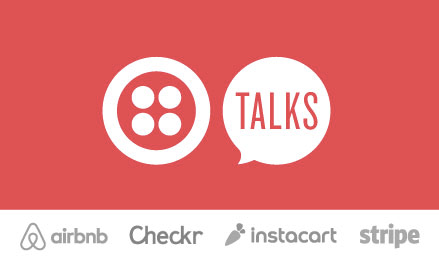What Powers The On-Demand Economy? A Talk With Chelsea Rustrum
Time to read:
This post is part of Twilio’s archive and may contain outdated information. We’re always building something new, so be sure to check out our latest posts for the most up-to-date insights.

Marketplaces are growing exponentially and popping up online in every sector. When you go to work, you share a Lyft or Uber. If you need a window replaced, you might call a Taskrabbit. If you want to book a spot to stay for your vacation, you’ll book an Airbnb.
We’re hosting a panel discussion at our HQ on April 26th with Airbnb, Instacart, Checkr, and Stripe to explore how different technology platforms enable the most successful on-demand services. Register here.

Industry expert, Chelsea Rustrum will be moderating the panel. She is the author of It’s a Shareable Life and founder of Sharers Talks and will help us dive into the elements that drive the growth of the sharing economy marketplaces.

I had a chance to sit down with Chelsea and pick her brain on the sharing economy in preparation for the meetup.
Is it correct to say that the “Sharing Economy” has become conflated with the “On-Demand Economy” term, which has a much broader scope. What have you seen as the evolution of the sharing economy and how has this model evolved year over year?
Yes, this is correct.
In 2011-2012, the sharing economy was just beginning. Most people still thought the idea of sharing their homes or cars was a bit crazy, but Airbnb and GetAround already had traction. At this point, the sharing economy was thought of as an altruistic way to share more efficiently to save time, money, and resources. People were excited about the social element of human connection through peer-to-peer transactions and exchanges.
2013-2014, there was mass adoption and more people were using marketplaces for full time income, replacing their jobs with gigs, contracts, and flexible work through sharing economy platforms like Uber, Lyft, and Airbnb.
2015, the Uber-ification of everything. This marks the rise of the on-demand economy where efficiency, deliveries, and services catered at the push of a button changed how we think about the sharing economy.
No one knew where these new companies fit in, so the industry came up with the term “on-demand” to describe services that are instantly bookable and typically wrap around on-site professionals and the delivery of goods as a service, through enhanced logistics.
This switch gave rise to a lot of venture capital influx and startups claiming stake in this sector.
2016, with multi-billion dollar valuations of sharing and on-demand services organizations, lawsuits and conflict with incumbents ensued in addition to the question as to what makes an employee versus a contractor. The contractor question also begs other questions, such as: who will protect the workers, how will they be taken care of long-term by way of unemployment, workers compensation, health care, and retirement.
What are, in your opinion, the main differences between the traditional e-commerce model with the new generation of marketplaces? What are the traits that differentiate the old from the new?
In the real world, you’d have to ask enough people to give you a ride or to crash at their place before you’d find someone who would say yes. And if they fell through, you’d probably be in a bind. With the sharing economy, you can get what you need when you need it from someone who has access to the resource you’re looking for, at the palm of your hand.
With traditional e-commerce, you don’t have access to the long tail of providers that are made available in peer-to-peer marketplaces, which means that these platforms have a much larger supply and wider scope of resources to draw from. Just think about it: Airbnb is the largest hotel chain in the world and yet they own no real estate and similarly, Uber is the larger taxi company and they don’t own a single car and nor do they employ drivers.
This isn’t possible with traditional e-commerce where you have to put out the capital to purchase everything from the get-go.
These new marketplaces are made possible because technology has given rise to online reputation, social networks, and reviews, which generates trust between strangers. Insurance, background checks, and communication mechanisms make it possible to talk without limiting privacy and these invisible layers of technology give rise to systems where strangers can feel safe in doing business with one another. The result is that we now expect to communicate with businesses in the same way we can reach out to friends and colleagues. With the same immediacy and over the same channels.
Are you seeing traditional companies and services transitioning to this new model? If so, which verticals in particular?
Many fortune 500-type companies are looking at the long-term of their business and if they are asset heavy, they are definitely thinking about offering access vs. retail ownership, are generating new marketplaces for the larger ecosystems to capture more of the market, and are thinking about how to remain relevant by playing the strengths of the rules of the new economy.
Larger, more established companies are also thinking about how they might emulate or integrate with existing marketplaces for labor or resources. Think: a TaskRabbit integration with IKEA built into the shopping experience or Regus working with Breather to expand their reach into smaller, more youthful on-demand office spaces around the world.
And finally, with the rise of on-demand services and deliveries, companies of all sizes will have to adapt to the changing landscape of business by offering equivalent timing and personalization, including the component of immediacy to their menu of options.
What advice would you give traditional companies or services evolving to this new model?
Consider what products that you have that could become services, what services could become marketplaces, and then look at the picture of your industry as a whole and think about how you can connect everyone.
The new model asks us to look at where value comes from and reward that as a result versus capturing, owning, or holding onto resources. There’s a lot just within that that will need to be unlearned before it’s too late.
Come Join Us!
During Twilio Talks, The Technology Layer of the Sharing Economy, we’ll discuss how the technologies that run in the background are, in large part, the reason the on-demand economy has taken such a strong foothold. Please join us!
Related Posts
Related Resources
Twilio Docs
From APIs to SDKs to sample apps
API reference documentation, SDKs, helper libraries, quickstarts, and tutorials for your language and platform.
Resource Center
The latest ebooks, industry reports, and webinars
Learn from customer engagement experts to improve your own communication.
Ahoy
Twilio's developer community hub
Best practices, code samples, and inspiration to build communications and digital engagement experiences.